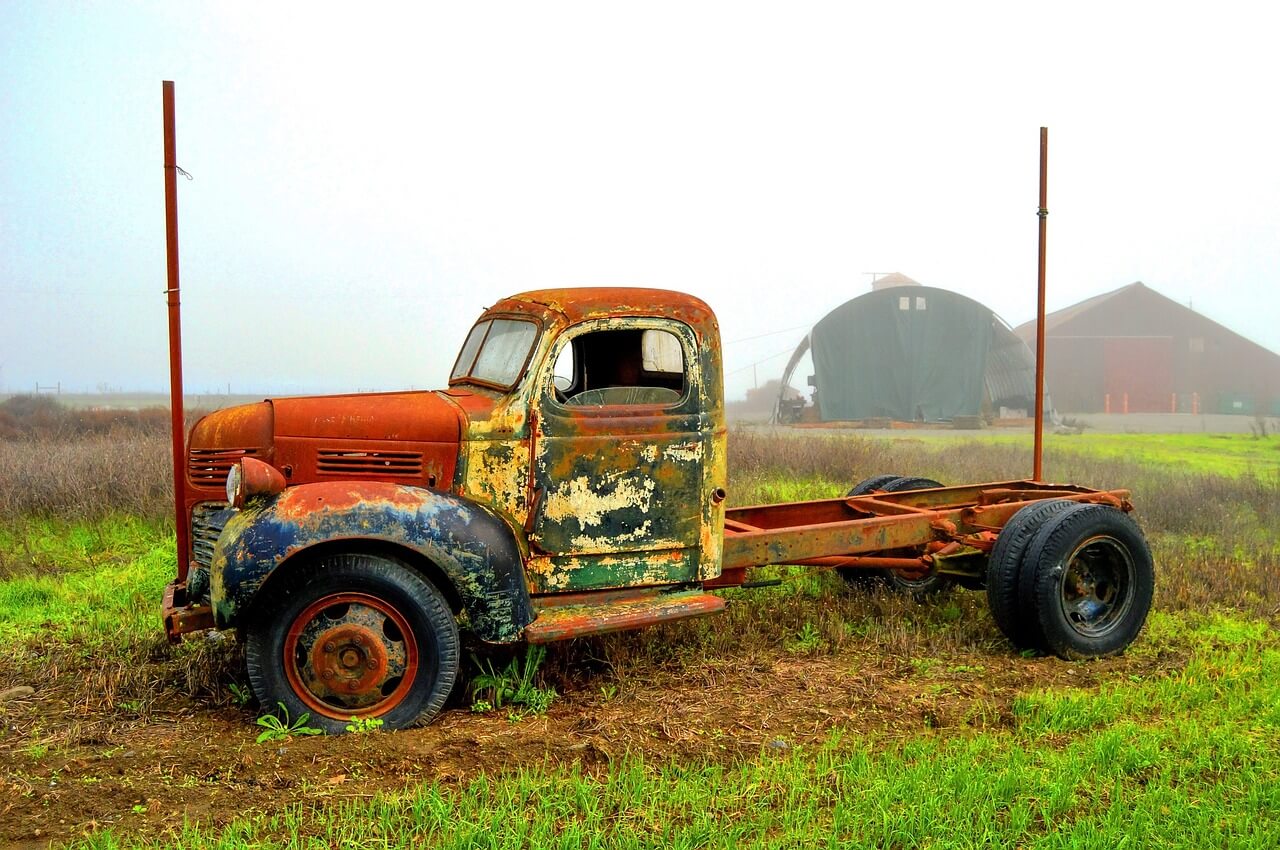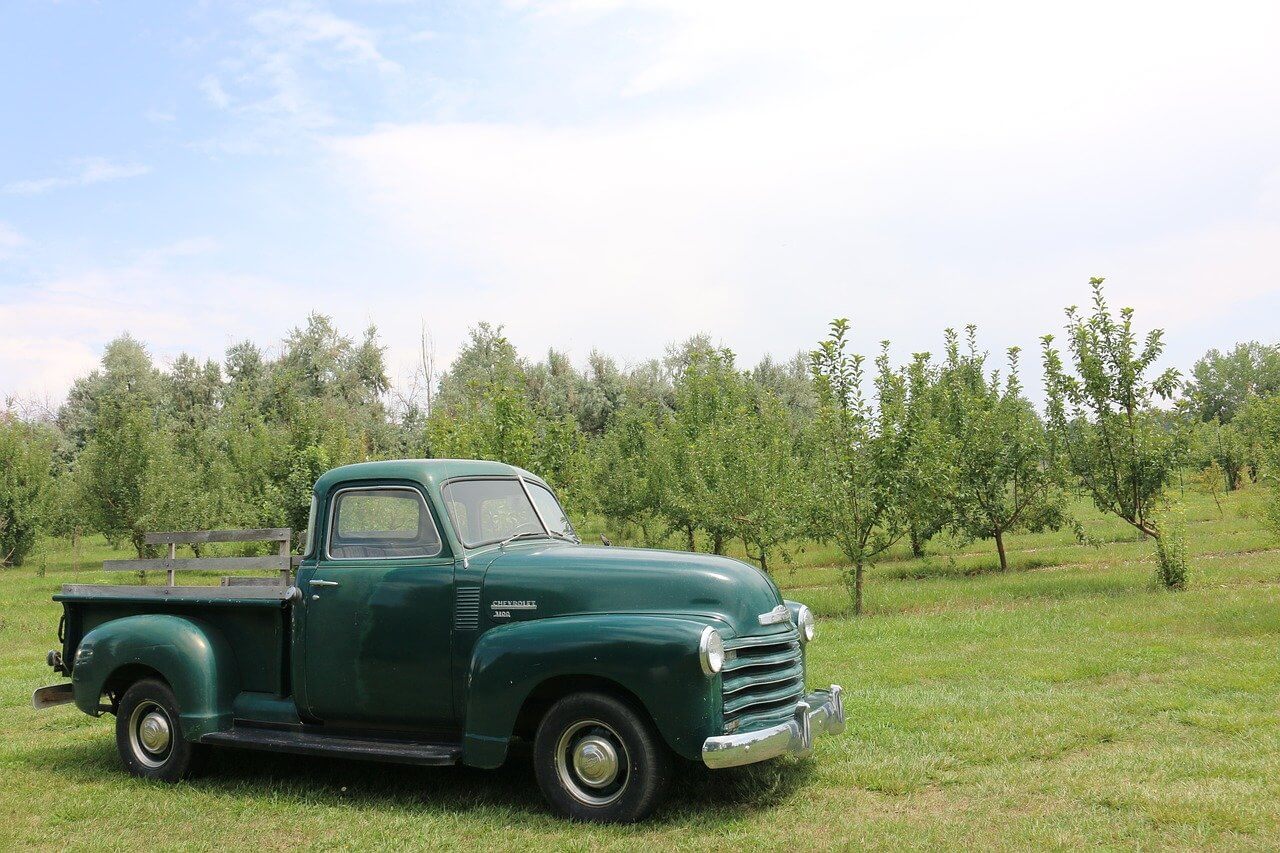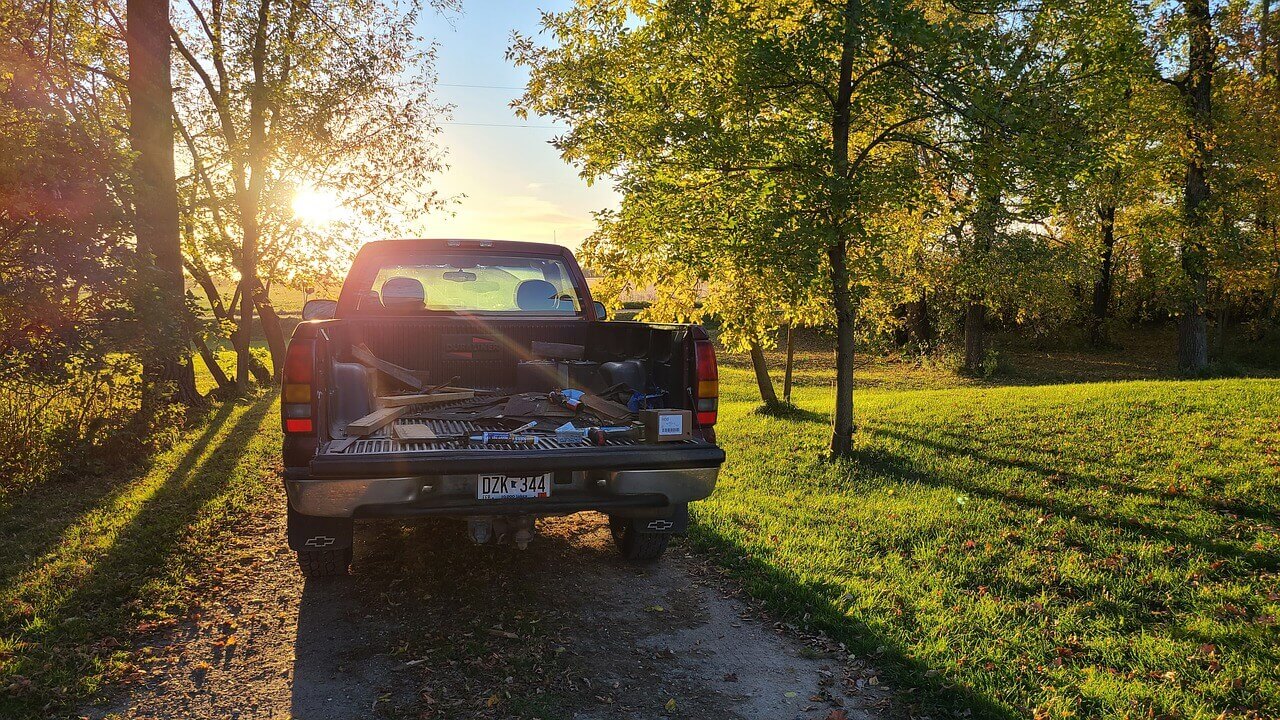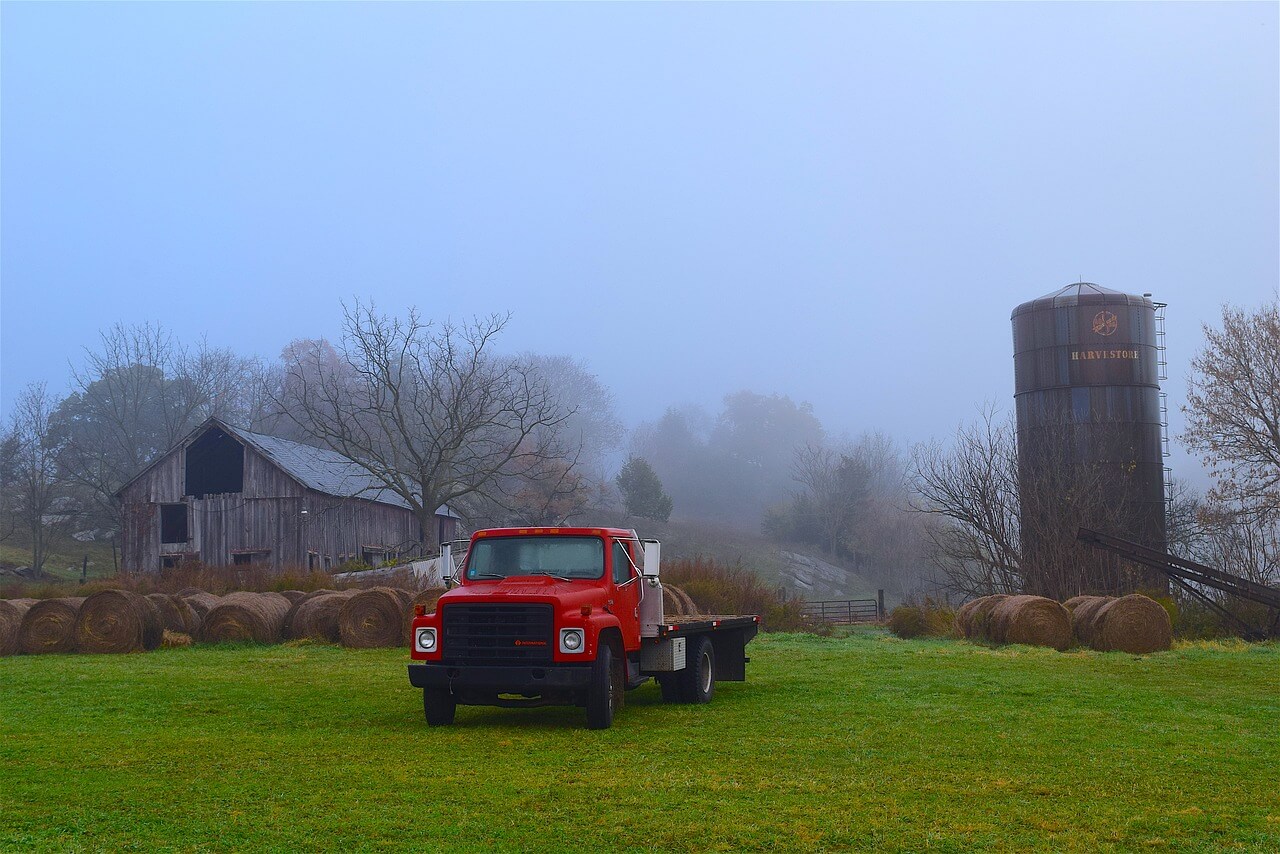Let’s be honest, they just don’t make things the way they used to. New trucks can cost a fortune and have many electronic components which often go wrong and require a computer technician rather than a motor mechanic to repair. Older, solidly built trucks without all the razzle-dazzle technology of today can seem almost indestructible when well maintained. So what to do with an old farm truck?
What You'll Learn Today
Is it Worth Restoring an Old Truck?

You’ll need to weigh up the pros and cons to answer this question. Things to consider include:
- Age of the truck
- Condition
- Value when restored
- Cost of restoration
- Can you do the job yourself
- Time available
- Budget
Age
Let’s start with the age of the truck. It could be that you already own an old truck, but it’s getting tired, and the miles are clocking up, or perhaps you need a truck and are trying to find the most economical way of getting something that will be reliable.
Whatever the case, you’ll need to assess the other points to work out if it’s worth restoring an old truck.
Condition
What is the overall condition of the truck you’re thinking about restoring? If the restoration required is fairly minimal, then it may be worth doing, but if you’re going to have to literally rebuild the thing, it may not be.
Value
Before starting any restoration, first ensure you know exactly what will need doing and how much it’s going to cost. Then work out how much the vehicle will be worth once restored.
Cost of restoration
If the repair price is going to be far more than the truck’s final value, it probably isn’t worth doing. But also take into account the cost of replacing the truck and make a judgment call.
It could be that even if you do buy a replacement that you’ll still have to pay out money on repairs.
DIY or Garage
Do you have the skillset to make all the necessary repairs yourself or at least the most expensive ones? Labor costs can be huge, and cutting out that expense will undoubtedly save a fortune, but only if you know what you’re doing.
Time
One thing people often forget to factor in when considering restoration is the time it takes to do. Time is money and is an expense you need to think about. Be realistic about how much time a restoration project will take.
Budget
It can be easy to underestimate the cost of repairing a vehicle, even if you will do the work yourself. An old classic may be worth the expense, but if you want a farm truck, then the costs involved may be too much.
Remember why you want to repair a vehicle. If it’s to save money, so you’ll end up with a reliable truck you can use on the farm, and you’re sure the budget you have will achieve that, then go for it.
If, however, the sums just don’t add up, it may be worth getting something that needs less doing.
What is the Best Old Truck to Restore?

Trucks have gained the status of fashion item in today’s society, and the latest models are more about looking good than working hard. But on the farm, a reliable truck is still the workhorse needed to carry out many heavy-duty tasks.
The price tag attached for a new truck with a long wheelbase and 4×4 can set you back $30,000 to $80,000, with the majority being around the $40,000 to $60,000 mark.
This can make restoring an old truck a very appealing option, particularly since farm trucks tend to get beat up pretty quick.
As for knowing which is the best old truck to restore, it will really depend on the job you need the truck to do and how much restoration you’re up for.
Let’s take a look at a few possibilities that could be worth your while.
- Chevy Silverado 2500HD 2001 to 2007 model 6.6L Diesel V8
This vehicle featured a Duramax diesel engine. Capable of towing heavy loads and durable enough for all your farming needs. The improved LBZ version is renowned for its reliability.
- Ford F-250HD 1994 to 1997 model Diesel V8
If you do your hunting well, you can pick up a 4×4 super cab heavy-duty version for under $9,000.
These are now becoming popular as modern classics, which is pushing up the price tag on already restored models.
The engine on this truck has been described as one of the most reliable diesel engines ever built. It has been known to exceed 500k miles and more.
Other variants have a 4×2 wheel drive and up to an 8ft bed.
- Dodge RAM D/W 250 1989 to 1993 model 5.9L Diesel
The simple cast-iron block engine in this vehicle was rugged, reliable, and well-engineered. The truck features a square body design and should have updated AAM axels for safety.
The 150 model is considerably cheaper, and a vehicle with 50k miles on the clock can be picked up for around $5,000. The lines of these trucks are beautifully simple and old-style classic.
In this video, you’ll see which five old trucks last for 400,000 miles or more:
Are Old Trucks Safe to Drive?
Sadly, unlike many other countries, no compulsory annual or bi-annual vehicle safety inspection is required in the United States.
Unsafe vehicles are often driven on the road, and most of the time, the driver has no idea that they are endangering themselves, their passengers, and other road users.
That aside, you can get your vehicle inspected for safety, and I highly recommend doing so. This isn’t just limited to old vehicles; even relatively new ones can have serious safety issues.
Before 1999 pickup trucks had no airbags, anti-lock brakes, or other safety equipment, unlike sedans. In fact, pickups were completely exempt from the federal safety regulations.
After 1999 pickups became subject to the same safety requirements as other cars. However, the Insurance Institute for Highway Safety who conducts vehicle safety tests and gives scores for how safe a vehicle is shows that many trucks are still lagging behind when it comes to safety.
In crash tests, trucks regularly fail to achieve good marks, often faring poorly in comparison to other types of vehicles.
In recent crash tests, pickup trucks have been found to be very poor on the safety front, particularly when it comes to passenger side impacts. This problem persists in trucks of all ages.
They have also been found to be more dangerous for pedestrians, with more people being hit and killed by larger trucks than ever before.
Safety features such as airbags, automatic braking, and anti-collision warning all help to improve the overall safety of modern trucks. Still, they are often built using weaker metals such as aluminum, making them crumple easier than old trucks will in a crash.
To ensure any truck you purchase is safe to drive, get it tested, and then keep up regular maintenance to keep it safe.
How to Make an Old Truck Reliable?

The key to keeping any vehicle running smoothly and ensuring it stays reliable is proper maintenance. Complete tips on this will be given in the section “How Can I Make My Old Truck Run Better” below.
By following these guides, you’ll help keep your old truck going strong and make it more reliable:
Warm-Up
Particularly with diesel engines, it is necessary to allow the heating coils or glow plugs to warm up before you try to turn on the engine. To do this, simply turn the key until the lights on the dash come on.
If your vehicle has a push-button automatic-start, simply push the button, and the vehicle’s engine management system will do this for you. That is why on a cold day, it can take a few additional seconds before the vehicle starts.
You should be able to see the heating coil warning light on your dash display. It is yellow and looks like a piece of wire with two loops in it.
With a manual start vehicle, all you need to do is wait until the light goes off and then start your engine. On particularly cold days, you can turn the key and wait for the light to go out and repeat this step several times before attempting to turn on the engine.
Once the engine is running, wait only 30 seconds before you start driving. It is polluting and wasting fuel to leave it any longer than this. Your vehicle will warm up far more quickly while driving than it would being left to idle.
It’s a good idea to turn on the blower fan or windscreen heater before turning on the car and allowing it to start heating and clearing your screen while you wait 30 seconds for the engine to warm up.
When you first start to drive, avoid sudden acceleration or pushing the engine too hard. Allow it to warm up fully, which will only take a few minutes of driving.
You will see the thermostat indicator rise. It should settle in the center of the gauge, showing the engine is warm but not hot.
Automatics – Reverse, STOP, Go
If your truck has an automatic transmission, it is vitally important to always bring the vehicle to a complete stop if you are changing from reverse to drive or drive to reverse.
Always follow the sequence Drive, Stop, Reverse and Reverse, Stop, Drive. Never jump straight from drive to reverse or reverse to drive while the vehicle is still in motion. This can rapidly deteriorate the gearbox.
Smooth and Gentle
Aggressive driving, such as taking corners at excessive speed, braking hard, or accelerating quickly, all put additional stress on your engine and other parts of your truck.
By taking the smooth and gentle approach and applying smart driving practices, your vehicle will remain in good condition for longer.
Read the Road
An important skill when driving is to read the road (or terrain) ahead and take evasive action to avoid potential hazards such as things in the road, curbs, bumps, potholes, dips, and so on.
By carefully circumnavigating these hazards, you will reduce the amount of wear on your truck’s suspension, tires, and steering and avoid the need for costly repairs.
Speed
There is an optimum speed at which your truck will cruise along using the least amount of fuel and causing the least amount of stress on the engine.
Driving at high or low speeds reduces fuel efficiency dramatically, and high speeds add additional stress to your engine’s components.
The optimum speed for your vehicle should be stated in the handbook.
How Can I Make My Old Truck Run Better?

As well as following the steps given above to ensure your old truck’s engine keeps running well for a long time, you’ll also need to take the following steps to ensure longevity and to keep your truck running better.
Oil
If you cover an average of 15,000 miles a year, then you’ll need to be changing your oil every six months. The oil should be changed every 7,500 miles at the very least. For older trucks, it is recommended to change it more frequently at 3,000 miles.
The best plan is to change your oil filter at the same time you change your oil. They are inexpensive and are important for preventing debris accumulating in your engine from damaging the moving parts.
Not all oils are the same either. Different oils are needed depending on your engine type, petrol and diesel engines, for example. Ensure you check which is the right type of oil for your truck.
For older engines, it’s better to use high-grade, fully synthetic oils that will keep things running smoother for longer.
Think of it this way; oil is like blood to your truck. Bad blood = sick truck. No blood = dead truck.
Tires
Your tires are probably one of the most important parts of your vehicle to keep well maintained. They are what keeps you in contact with the road, and a sudden blowout can cause a devastating accident.
Not only do the tires need to be checked for wear, damage, and inflation level, all things you can easily do yourself. They also need to be kept correctly aligned and balanced, so they rotate smoothly and evenly.
This is very important for the balance, ride, fuel efficiency, and performance of your vehicle, but also to prevent excessive wear on your suspension.
Do a daily inspection yourself and look out for things like uneven wear and bald spots, which may indicate you have bigger issues.
Get your tires balanced and aligned every six months.
Filters
Not only will your oil filter need to be changed, but your fuel and air filters too. Your engine needs a constant supply of fresh air when running, but as you drive, it also takes in dust, pollen, insects, and other debris that clog up the airflow.
By changing your air filter every 15,000 to 30,000 miles, you’ll help your engine breathe more easily and improve performance and fuel consumption, as well as prolonging the life of your engine.
Fuel filters ensure that no dirt or debris can get into your engine from your fuel tank. But once the filter itself becomes blocked, it will stop working efficiently and can cause a host of problems, including difficulty starting, spluttering, loss of power, and poor performance.
The fuel filter should be changed every 20,000 to 40,000 miles depending on your truck. New trucks may go as many as 60,000 miles before a new filter is required.
Pumps
The fuel pump is another important component that keeps the fuel running smoothly from your tank and around your engine. These pumps will need routine replacement. Check with your manufacturer or mechanic about how often this requires doing for your make and model.
Water pumps circulate coolant fluid around your engine to prevent overheating. These are typically changed at the same time as your timing belt.
Timing belts or chains
This essential component can have a catastrophic effect on your engine if it fails and will destroy it often beyond repair.
It is vital to renew timing belts and chains at the recommended time-frequency in order to avoid such failures.
Often people mistakenly believe that vehicles with chains don’t suffer from this problem, but they are mistaken. Although a timing chain will last longer than a belt, it will still require replacement according to the vehicle manufacturer’s instructions.
Hoses
If you look inside your truck’s engine, you’ll see a variety of different hoses. These are required to carry out a variety of jobs and carry air or fluids around the engine.
Over time these hoses deteriorate and require replacement. A leaking hose can cause engine performance issues or even a catastrophic loss of fluid that could result in a breakdown or even a serious accident.
Ensure your hoses are checked annually when you get the vehicle serviced.
Breaks
Good brake maintenance is essential to prevent accidents. Replacing brake pads, discs, and calipers, as required, is a critical part of your vehicle’s maintenance. Have your brakes checked every six months, along with the brake fluid lines, hoses, and brake fluid level.
Steering and Suspension
You’ll need a qualified mechanic to check the steering and suspension of your truck during its annual service.
I have personally had the misfortune to be driving a truck with a trailer when the steering failed. I lost all ability to turn to the left.
It was a scary experience and happened without any warning. Luckily I was only traveling at low speed as I had animals in the trailer.
Read the Manual
As with anything, having a good working knowledge of your vehicle is powerful. Read the manual carefully and get to know how your truck works. Pay particular attention to maintenance schedules and correct procedures.
Unless you have received proper training, you won’t be able to safely do all the necessary jobs yourself. If you aren’t 100% sure how to do something, always get the help of a professional.
Conclusion
If you have the skillset and time to restore an old truck, then it may be worth doing as considerable savings might be made. If it’s a classic, then you may even be able to sell it and use the proceeds to go towards a new one.
Older trucks were built more simply than the modern ones of today, and although they lack some of the modern safety features, they are often more durable, and the engines can easily outlast the high-tech versions we see in new models.
Please note that this article is meant only as an overview and is in no way meant to reflect the full facts, regulations, or legislation regarding any legal aspects mentioned at any level. Complete information must be sought from the appropriate official bodies.
We have other farm truck articles available on our site. Take a look to find out more in this guide about registering a farm truck.